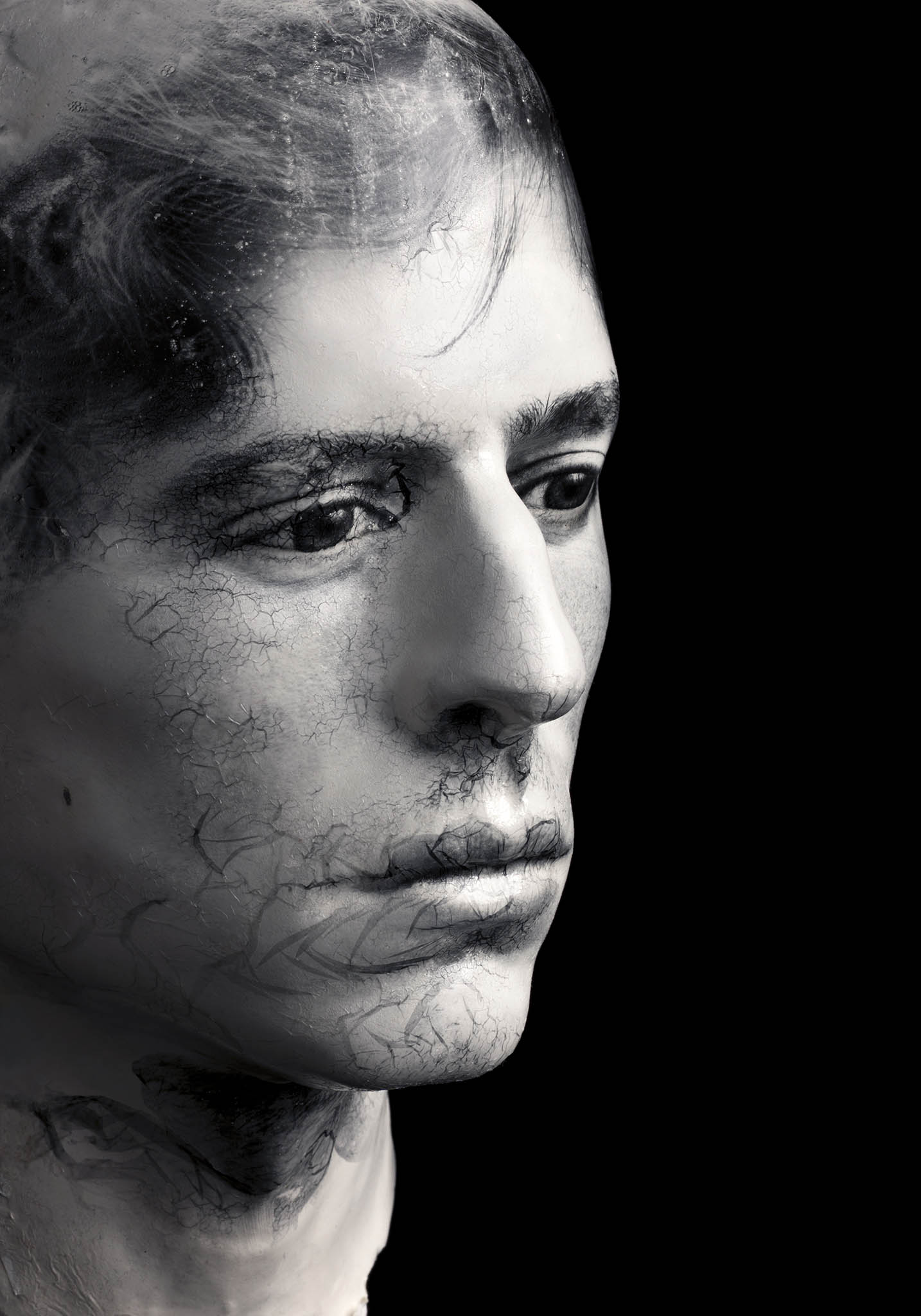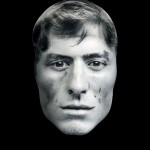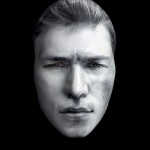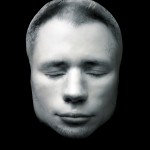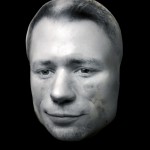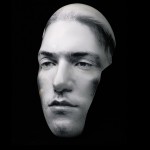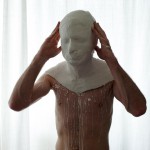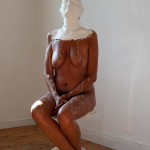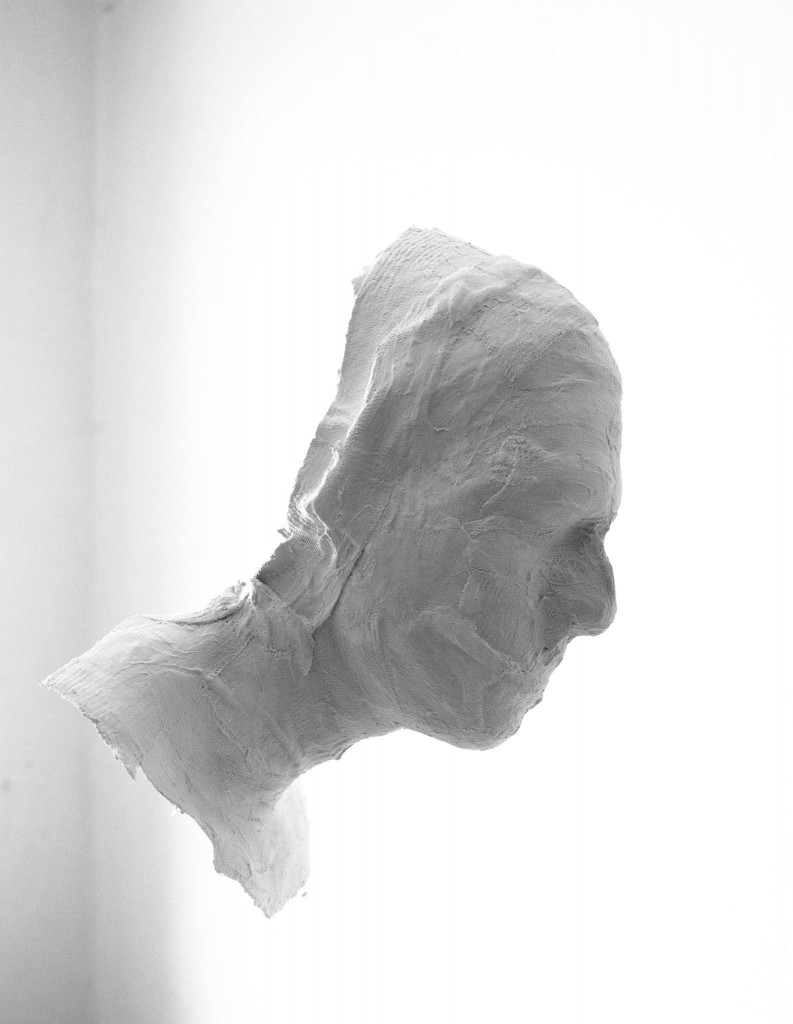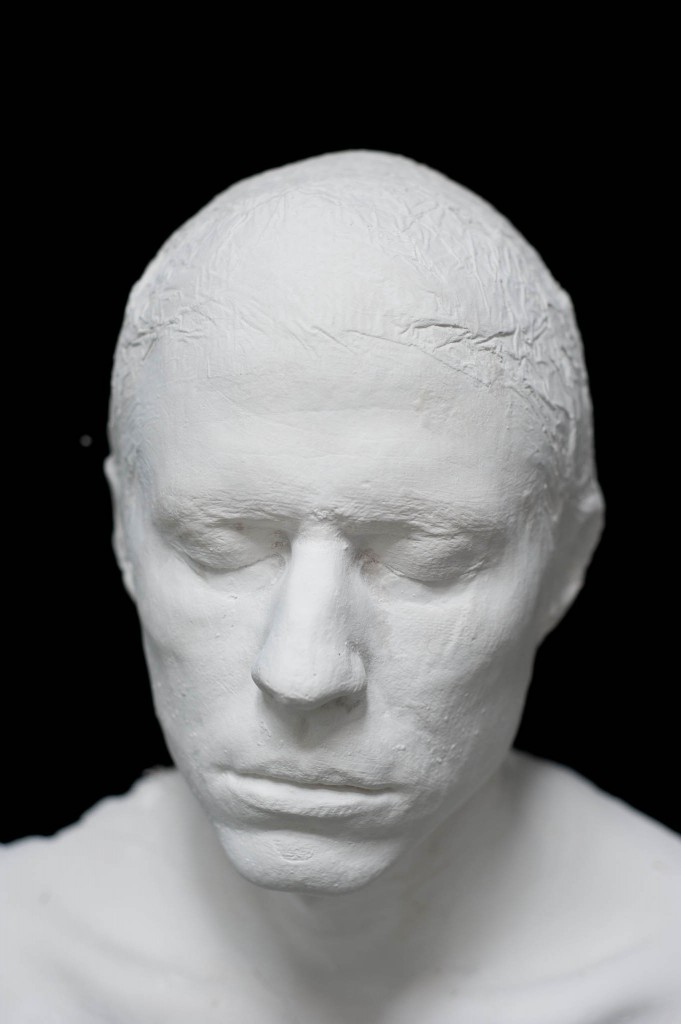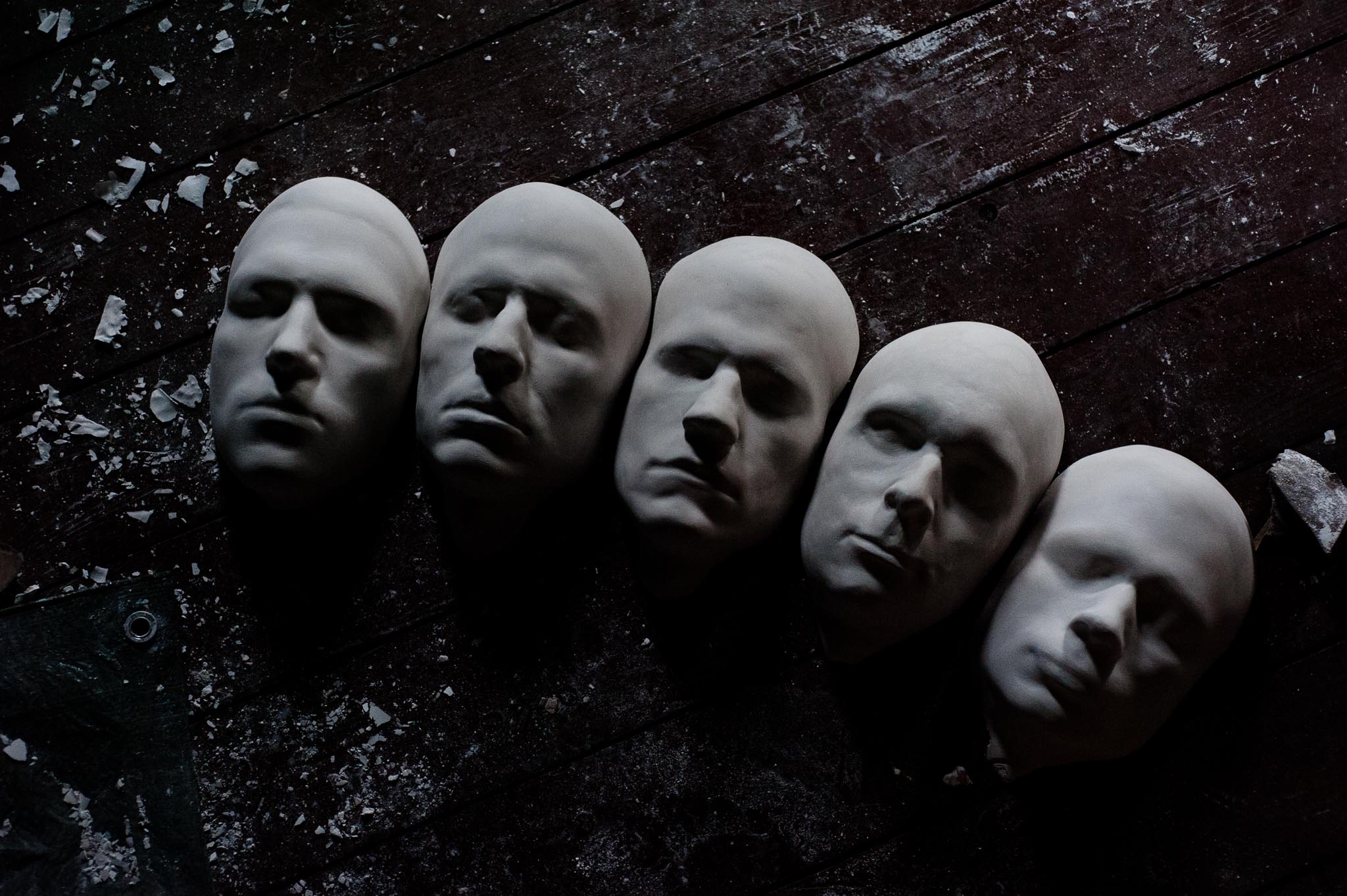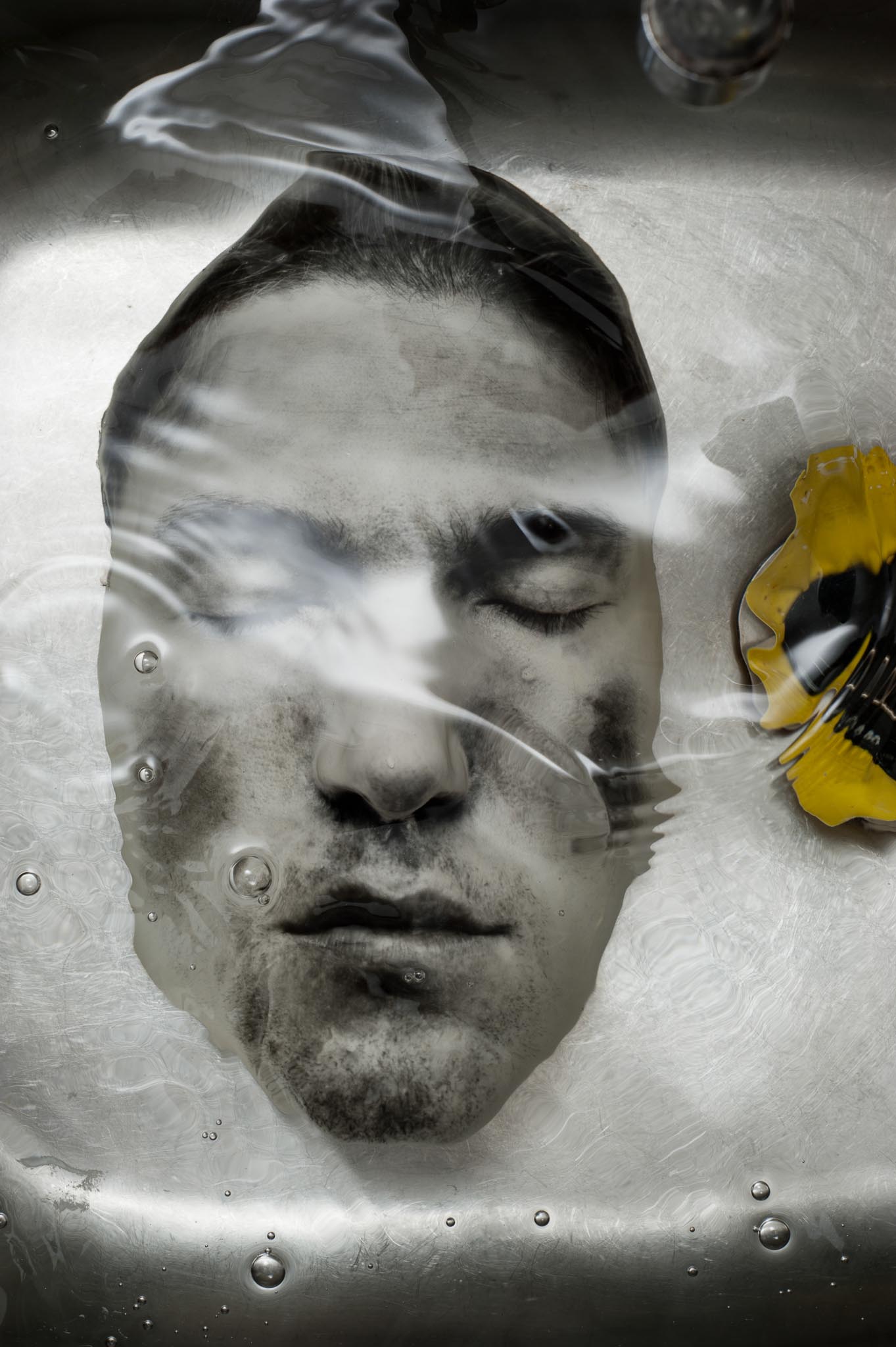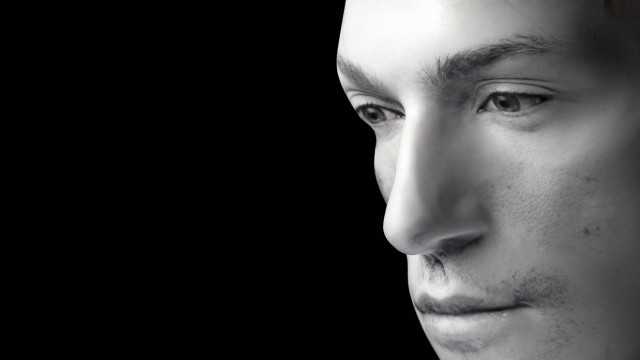
Fotoplastiken
Photo-Sculptures 2013-2014
Plaster casts were used to preserve a record of people‘s facial features for posterity, long before the invention of black and white photographs. It wasn‘t until the introduction of photography that this mode of “portraiture” slipped out of vogue.
These photo-sculptures began as an attempt to unify the information contained in both of these positive-negative mediums, the photograph and the plaster cast. However, my aspiration of creating a “better” likeness, one even richer in information, gave way to the realisation that even such a perfect image would be an abstract one. What I mean by “abstract” is, that we don’t view the objects we’re confronted with as self-referential; instead we read them as a reference to what we believe they represent. The more accurate the reproduction, the truer this seems: When it comes to our own reflection in the mirror, we barely even make the distinction between the image and ourselves.
Sometimes we are drawn to certain people. Other times we find ourselves wanting to look away. Why is this? Are we really seeing these people in the here and now? Or do we take them as references, making them into projection surfaces for our own imagination? With the latter, our projections sometimes fit, but sometimes they don’t. My process for producing the photo-sculptures is analogous. After painting the sculptures in the darkroom with photosensitive silver gelatin, I project an image onto them which I then develop using photo chemicals. But no matter how much care I take to find the “right perspective”, the image bearer and the image never end up being 100 percent congruent. It’s this margin of difference and the independence that the work gains through the developing process that push us to reconsider our perceptions in general. by Ilia Beckmann 2013
Our minds work a bit like emotional darkrooms, where pictures are constantly developing of the world, of ourselves and of others. We create images of each other, consciously or subconsciously, filtered through our own experiences, fears and desires, and then we project these images back onto the people we meet (or even just see online).
But what happens when we do? If we’re honest, we see that our projections never exactly line up with reality.
My photo-sculptures are an exploration of that phenomenon as well as of the medium of photography itself. The technique – making plaster sculptures of models’ faces, coating the sculptures with silver gelatin and then exposing them with analogue black-and-white portraits of the same models – was born of an attempt to create a sort of hyperphotograph, a more exact likeness than a conventional photo.
But that’s not what happened. Once the plaster sculptures were exposed, abstractions of the models’ faces were unavoidable. No matter how clear the negatives were, or from what angle I shot the photos or exposed the sculptures, distortions occurred in the process of projecting my images back onto these three-dimensional surfaces. My failure to create perfect objects out of human beings – living sculptures that I could own – resulted in something like a death mask.
The essayist Susan Sontag once wrote of photography in terms of killing:
“To photograph people is to violate them, by seeing them as they never see themselves, by having knowledge of them that they can never have; it turns people into objects that can be symbolically possessed. Just as a camera is a sublimation of the gun, to photograph someone is a subliminal murder.”
One aspect of my photo-sculptures is understanding how we as humans (and I as a photographer) try to transform people into objects that we can know and possess. But if all we know of each other is the projection of our own images, what is it we really own?
Ilia Beckmann, Berlin June 2019.
MAKING OF
Life and death in photography
In regard to Roland Barthes‘s „Camera Lucida“
My intent in creating a realistic likeness actually led in the beginning stages to creation in the opposite direction: My first photo-sculptures resembled decay and decomposition. When I showed them to people, images of death masks were evoked. This inspired me to research into the literature of photography in relation to life and death. Roland Barthes discusses this topic in his work „ Camera Lucida“. Although – or perhaps because – I wanted to create a particularly convincing effigy, I was pushed to peruse the very theme of death itself within photography. One can only gain full comprehension of the concepts of life and death when one considers the polarity of the dark and light, black and white. The more aware we are of our mortality, the more we grasp for life‘s worth. The older a photographic work is, the more nostalgic and magical it becomes to us: When we are confronted with an image of a loved one in their prime, we see blossoming life, someone who may even have passed away; we are moved deeply. An image such as this holds this person alive in our mind. In this sense photography can render immortal. The genre of memento mori (“reminder of mortality”) has a strong presence in art history which will stay within art history for all time. A condition for this is the memento vitae (“reminder of life”) as a compulsion for the production of pictures, breathing life into a work via artistic craft.
As time passed, I improved my ability in developing the photographic images onto the ceramic casts, which by a refinement of the shade contrasts, gave the impression of a real-life face. The photo-sculptures became realistic and life-like as a result. However the three-dimensional appearance, which lent such realism, did have the effect of representing an object, which contrastingly threw images forward of lifelessness and objectivity. Generally speaking, when we view a two-dimensional photograph, we take no account of the medium itself. This is not so much the case with photo-sculptures. Through their embodiment, they are more than just indicators. The works are both themselves and something else, both in the here and now and onwards. We do not question the authenticity of perfectly aligned frames, notwithstanding their brutal displacement, a cutting from the world whence they came. In an opposing way, the faces of the photo-sculptures, abruptly ending, can irritate, especially when one sees them as plain photographs. The cut-off points have a particularly brutal effect here. The living quality of the photo-sculptures ends thereby very suddenly, surrounded by black. By nothingness.
In the following I shall describe the basic thought processes of Roland Barthes in relation to my photo-sculptures. Barthes‘ thoughts brought him to seek the properties of photography in its essence. He grasped „reference“ as the basic principal of photography, writing, „It is not the photograph that you see“ and „I was only seeing the reference, the desired object, the beloved form“. The representative had actually been present: „The necessarily real object, that had been positioned before the lens, without which there would be no photograph“. This differentiates from painted works of imagined subjects. Painted works imitate, whether as photography acts as a witness. Beholding photographic works gives a connection to reality and the past.
Barthes’ thoughts about reference as a basic principal of photography became questionable at the latest in the age of digital manipulation. Today the quandary of representation is omnipresent. This is most certainly one of my motives for developing the photo-sculptures. I gave myself the task of producing a representative cast form, an image rich in information, three-dimensional in 1:1 scale and as life-like as possible. The beholder should experience the feeling of being confronted by an actual face, not just a representation. The physical process of photography is important to Barthes: “Rays of light reached me, as I there was, coming from a real object that once existed; (…) a kind of umbilical cord connects the body of the object, which is being photographed, into my view: the light, although untouchable is an embodied medium here.” He calls this “emanation of the representative”. The photograph is neither imitation nor just a picture. The light rays from an object that was once existent, present, end up with the beholder despite a delay and withholding. In this way photography is “neither an image nor reality”, “something real that one cannot touch”. At this point Barthes’ thoughts move on to the Christian worldview and into the metaphysical. The photo-sculptures appear differently here. Because they are now sculptures within a space, it is now obvious that they can be touched. The body of the photo-sculpture is there but, according to Barthes, the photograph transports the essential quality thereof further on. The reachable and the unreachable are polarised much stronger in a photo-sculpture than in a conventional two-dimensional photograph. The photo-sculptures are reality, a reality in the here and now, and in spite of this we are not able to pursue the “essential”. It’s quite spooky.
Barthes explains further that photography would in fact have to be considered within the field of alchemy, were society to have a sound understanding of legend. Using the strength of a “fine metal”, photography renders the “beloved body eternal”, a further allusion to the resurrection. When the photo-sculptures
are viewed under certain light conditions, they glimmer silver, as would a pearl. Their three-dimensional quality and their association with death masks really does transform them into eternal bodies made out of a fine metal.
This is where the dialectic starts between life and death. Because of photography’s properties of reference and emanation, there is a “disturbing aftertaste”. In all photography and especially in old photographs, there is a special quality of the “recurrence of death”. The photograph proves the past existence of a person in a portrait. In addition to this, physical rays of light which belong to the person are emitted here. These rays travel through time via photography to reach the viewer in the present. In this way photographs are “the past and reality as one”, or to put it differently: “the living picture of something no more”.
Photography’s character of reference allows the viewer to consider the objects in a photo as real, thereby allowing the assumption that they are living. Because photography recreates the past, this also means conversely, that the photographed object as it was captured is already dead. “Photography flows, unchanged, from presentation back to guardedness”.
It is not only within the medium of photography that its self-occurring phenomena can be read in connection to death. This can also happen within photography as an action. Death is also contained within the picture-making process of the subject. The subject desires and even demands to be sufficiently represented, because the subject knows that every photograph is an expression of itself. The ego is independent of every picture but, in spite of this, it wants to correlate with the picture. In this way everything does become very strange. The subject imitates itself. During the recording the subject is neither subject nor object; it is “much more a subject, that feels it is becoming an object“. Barthes compares this phenomenon to the event of death. The subject forms itself into an object. It strips one of oneself. It is now a “picture in its entirety (…) that is to say, death personified”.
As a practicing photographer I have always felt very strongly what Barthes describes here: As soon as I take a picture of somebody in most cases I make an object out of that person. I feel I make this phenomenon very clear with my photos- sculptures. Barthes goes on to say that photography has taken on considerable cultural change. It has objectified the subject. This has caused and still causes great disruption “. Photography, “is the presentation of myself as somebody else; a sly dissociation of the awareness of identity”.
A further important factor is the operator, that is to say each person who shoots the photo. This person is also aware of the analogy to death. He shoots his camera and distorts himself into various positions, without the aim of killing at all. The photo should look as life-like as possible. Barthes calls this the “embalming”. He describes the action of photography as having a generally devastating or rescuing effect on life. The photographer carries the responsibility. If he wants to recreate a person adequately “as that person is”, then he has to avoid similarity. Similarity is described here as “mask-like”. Instead of this, the individual expression must be transported, without which only an extradited body remains on the photo. Written by Ilia Beckmann, translated by Zackoriah Holland, 2014.
Literature:
Barthes, Roland: Die helle kammer. 14 Auflage. Suhrkamp Verlag, Frankfurt am Main, 1985.
Leben und Tod in der Fotografie
Bezüge zu Roland Barthes „Helle Kammer“
Mein Wunsch ein besonders lebensechtes Abbild zu schaffen, führte zu Anfang in die entgegengesetzte Richtung: Die ersten Fotoplastiken sahen nach Alter und Zersetzung aus – sie erinnerten an Totenmasken und führten mich zu einer intensiven Beschäftigung mit dem Thema Leben und Tod. Roland Barthes beschreibt das Thema in seiner Schrift „Die Helle Kammer“. Obwohl oder gerade weil ich ein besonders „lebendiges“ Abbild schaffen wollte, musste ich mich mit dem Todeshaften der Fotografie auseinandersetzen. Erst in der Gegenüberstellung bekommen die Begriffe Leben und Tod, schwarz und weiß, Licht und Schatten ihre volle Bedeutung. Wir klammern uns umso stärker ans Leben, desto klarer der Tod in Erscheinung tritt. Umso älter Fotografien werden, desto magischer ist ihre Wirkung auf die Gegenwart. Es ergreift zu tiefst einen geliebten Menschen, der vielleicht schon von uns gegangen ist, auf einem Foto in voller Blüte zu „erleben“. Solch ein Bild hält den Menschen in unserem Geiste am Leben. In diesem Sinne macht Fotografie unsterblich. Das Sujet des Memento-Mori (Bedenke, dass du sterben musst) zieht sich durch die Kunstgeschichte und wird niemals seine Brisanz verlieren. Das Memento-Vitae (Bedenke das Leben) als den Drang Bilder zu produzieren, ja ihnen durch Kunstfertigkeit Leben einzuhauchen, ist dafür Voraussetzung.
Mit der Zeit gelang es mir immer besser, ein Bild auf die Plastiken zu entwickeln, das einen so fein nuancierten Tonwertumfang hat, dass es den Anschein erweckt, wir sähen ein echtes Gesicht. Die Fotoplastiken wurden realistisch, und damit lebendig. Nicht zuletzt trägt ihre Dreidimensionalität entscheidend zu diesem Realismus bei. Doch gleich darauf lässt eben diese Dreidimensioanlität wieder alles auffliegen. Sie zeigt nämlich, dass es sich um ein Objekt handeln muss und eben nicht um einen Menschen. Bei einem zweidimensionalen Foto blenden wir das Medium in der Regel automatisch aus und können dadurch tatsächlich einen Menschen anstatt ein Foto sehen. Bei den Fotoplastiken geht das nicht so einfach. Durch ihre Körperlichkeit sind sie mehr als nur ein Verweis; sie sind sowohl sie selbst als auch jemand anderes – Sie sind Diesseits und Jenseits.
Den perfekten rechtwinkligen Rahmen normaler Fotos nehmen wir als natürlich hin, obwohl er seinen Bildinhalt brutal aus der Welt schneidet. Im Gegensatz dazu verstören die abrupt endenden Gesichter der Fotoplastiken, besonders wenn wir sie wiederum als Fotografien betrachten. Die Schnittkanten wirken hier tatsächlich befremdlich. Die Lebendigkeit der Fotoplastiken nimmt dort ein jähes Ende, sie sind umgeben von Schwarz, von Nichts.
Im Folgenden werde ich die grundlegenden Gedanken Roland Barthes darlegen und diese mit den Fotoplastiken ver- gleichen.
Barthes macht sich in seinen Überlegungen auf die Suche nach dem „Eigentümlichen“, dem „Wesen“ (Barthes 1985, S.11) der Fotografie. Dabei begreift er letztendlich die „Referenz“ (S. 87) als das Grundprinzip der Fotografie. „Es ist nicht das Foto, das man sieht“ und „ich sah immer nur den Referenten, den ersehnten Gegenstand, die geliebte Gestalt“(S.15). Das Dargestellte ist wirklich gewesen. „Die notwendige reale Sache, die vor dem Objektiv platziert war und ohne die es keine Photografie gäbe“(S. 86). Dies grenzt sie von der Malerei ab, die ausgedacht ist. Malerei imitiert, während Fotografie be- zeugt. Das Betrachten von Fotografien lässt eine Verbindung zu Realität und Vergangenheit entstehen.
Barthes Überlegungen zur Referenz als Grundprinzip der Fotografie, sind spätestens im Zeitalter der digitalen Manipulation fragwürdig geworden. Die Krise der Repräsentation ist heute allgegenwärtig. Diese ist sicherlich eines der Motive für die Entwicklung der Fotoplastiken. Ich stellte mir die Aufgabe, ein repräsentatives Abbild zu produzieren, ein Bild reich an Information, dreidimensional im 1:1 Maßstab und so lebendig wie möglich. Es sollte dem Betrachter das Gefühl vermitteln, nicht mit einer Darstellung, sondern einem echten Gesicht konfrontiert zu sein.
Barthes ist der physische Vorgang beim Fotografieren wichtig. „Von einem realen Objekt, das einmal da war, sind Strah- len ausgegangen, die mich erreichen, der ich hier bin; (…) eine Art Nabelschnur verbindet den Körper des fotografierten Gegenstands mit meinem Blick: das Licht ist hier obschon ungreifbar, doch ein körperliches Medium“(S. 91). Er nennt das „Emanation des Referenten“ (S.90). Das Foto ist weder Imitation, noch nur ein einfaches Bild. Die Lichtstrahlen von einem existenten, dagewesenen Objekt gelangen trotz Verzögerung und Konservierung zum Betrachter. Somit ist die Fotografie „weder Bild noch Wirklichkeit“, „etwas Wirkliches, das man nicht berühren kann“ (S. 97). An dieser Stelle führen die Überlegungen weiter ins christliche Weltbild und ins Metaphysische.
Die Fotoplastiken verhalten sich hier etwas anders. Da sie skulptural im Raum stehen, ist offensichtlich, dass sie sehr wohl angefasst werden können. Der Körper der Fotoplastik ist da, aber nach Barthes transportiert die eigentümliche Wirkung weiterhin das Foto. Das Greifbare und Ungreifbare polarisiert sich in einer Fotoplastik noch stärker als im konventionellen flachen Foto. Die Fotoplastiken sind Wirklichkeit, greifbare Wirklichkeit, und trotzdem entzieht sich uns das „Wesentliche“. Es ist geisterhaft.
Weiter beschreibt Barthes, hätte die Gesellschaft Sinn für Mythos, müsste die Fotografie zum Bereich der Alchemie gerechnet werden. Sie macht Kraft eines „kostbaren Metalls“ den „geliebten Körper unsterblich“ (S. 91), eine weitere Anspielung auf die „Auferstehung“ (S. 92).
Betrachtet man die Fotoplastiken unter bestimmten Lichtbedingungen, schimmern sie perlmuttartig silbern. Ihre Dreidimensionalität und die Assoziation mit Totenmasken, macht sie tatsächlich zu unsterblichen Körpern aus kostbarem Metall.
An diesem Punkt setzt die Dialektik zwischen Leben und Tod an. Aufgrund der Referenz und Emanation, entsteht ein „unheimlicher Beigeschmack“ (S. 17). Fotografien, besonders die alten, haben die „Wiederkehr des Toten“(S. 17) zu eigen. Das Foto beweist die vergangene Existenz eines abgebildeten Menschen. Gleichwohl strömt es physische Licht- spuren aus, die dem fotografierten Menschen gehören. Diese gehen mit der Fotografie durch die Zeit hindurch und erreichen den Betrachter in der Gegenwart. Fotografien sind somit „das Vergangene und das Wirkliche zugleich“ (S. 93) oder anders formuliert: „das lebendige Bild von etwas Totem“. Der Referenzcharakter der Fotografie lässt den Betrachter die Objekte im Foto für real halten. Er geht davon aus, dass sie lebendig sind. Da die Fotografie aber die Vergangenheit wiedergibt, bedeutet das im Umkehrschluss, dass das fotografierte Objekt bereits tot ist. „Unbeweglich fließt die PHO- TOGRAFIE von der Darstellung zurück zur Bewahrung“ (S. 100).
Nicht nur die im Medium Fotografie selbst liegenden Phänomene können in Beziehung zum Tod gelesen werden, son- dern auch das Fotografieren als Handlung. In der Bildmachung des Subjekts ist der Tod auch enthalten. Weil das Subjekt weiß, dass ein Foto immer ein „Ausdruck“ seiner selbst ist, entstehen der Wunsch und die Herausforderung sich hinreichend repräsentiert zu sehen. Das „ich“ ist „unabhängig von jedem Bild“ möchte aber trotzdem mit seinem Bild überein- stimmen. Dadurch wird das Ganze ein „bizarrer Vorgang“. Das Subjekt ahmt sich selbst nach. Während der Aufnahme ist es weder Subjekt noch Objekt, „sondern vielmehr ein Subjekt (…), das sich Objekt werden fühlt“. Dieses Phänomen wird mit dem Ereignis des Todes verglichen. Das Subjekt verarbeitet sich zum Objekt, es entäußert sein selbst. Es ist „GANZ UND GAR BILD geworden (…), das heißt der Tod in Person“. (S. 22 ff)
Als praktizierender Fotograf habe ich das, was Barthes hier beschreibt, immer stark empfunden: Sobald ich jemanden fotografiere, mache ich in den meisten Fällen ein Objekt aus ihm. Mit den Fotoplastiken treibe ich dieses Phänomen auf die Spitze.
Barthes setzt fort, dass die Fotografie eine nicht zu unterschätzende, kulturgeschichtliche Veränderung eingeläutet habe. Sie objektivierte das Subjekt. Das ging und geht immer noch mit Störungen einher. Die Fotografie „ist das Auftreten meiner selbst als eines anderen; eine durchtriebene Dissoziation des Bewusstseins von Identität“ (S. 21).
Ein weiterer wichtiger Faktor ist der Operator, also jener Mensch, der das Foto schießt. Auch er ist sich über die Analogie zum Tod bewusst. Er schießt und führt seltsame Verrenkungen aus, um doch nicht zu töten. Das Foto soll möglichst lebendig aussehen. Barthes nennt es das „einbalsamieren“ (S.22). Der Tätigkeit des Fotografierens schreibt er eine generell lebensvernichtende oder lebensspendende Wirkung zu. Die Verantwortung trägt der Fotograf. Will er einen Menschen adäquat wiedergeben „so wie er an sich ist“, dann muss die Ähnlichkeit umgangen werden. Die Ähnlichkeit wird hier als „maskenhaft“ beschrieben. Stattdessen muss der individuelle Ausdruck transportiert werden, ohne ihn bleibt auf dem Foto nur ein entseelter Körper. „Durch diese feine Nabelschnur stiftet der Photograph Leben; und versteht er es nicht, (…), der durchsichtigen Seele ihren hellen Schatten zu geben, so bleibt das Subjekt für immer tot“(S. 121). Ilia Beckmann 2014.
Literatur:
Barthes, Roland: Die helle Kammer. 14. Auflage. Suhrkamp Verlag, Frankfurt am Main, 1985.
